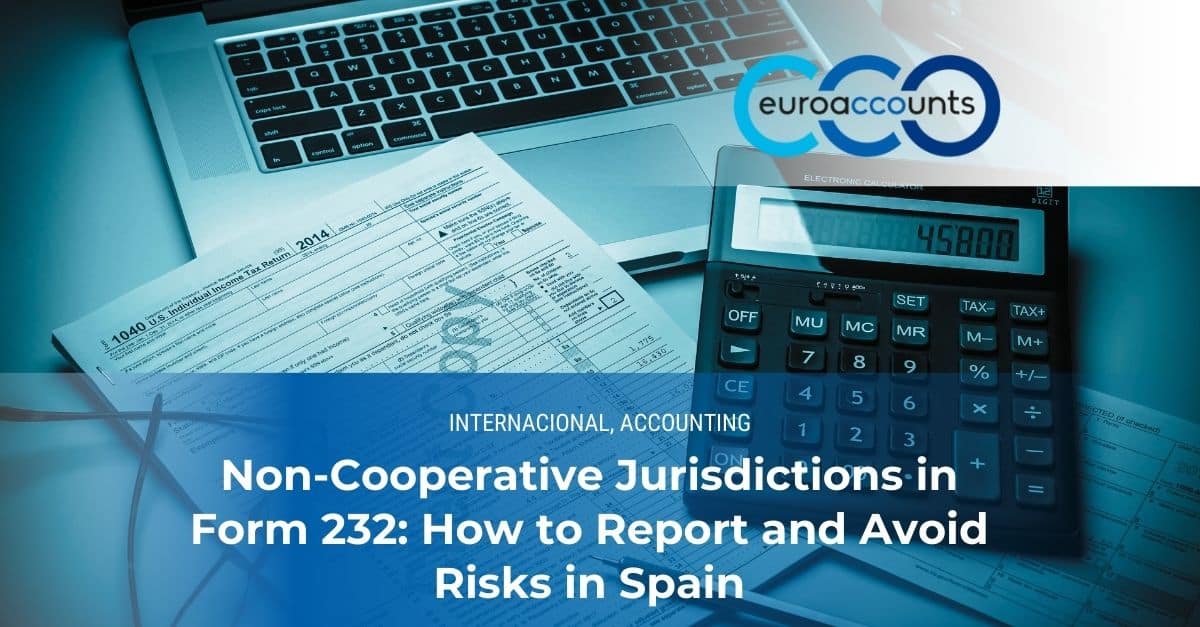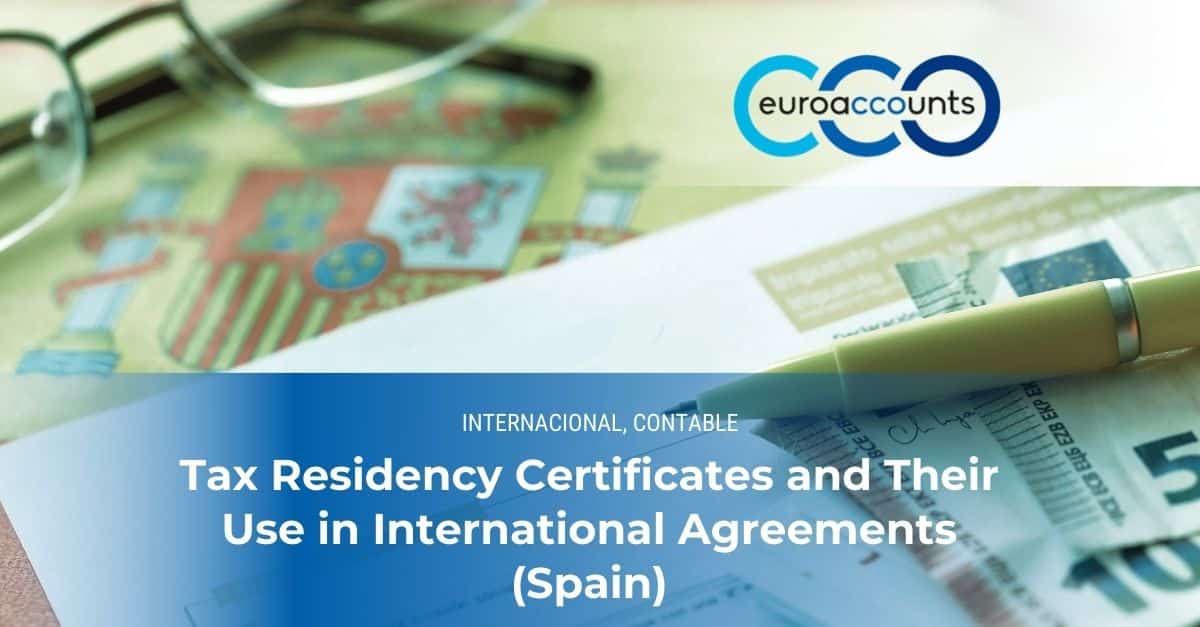The Form 200 is the annual Corporate Income Tax (CIT) declaration in Spain, a mandatory requirement for subsidiaries of multinational groups operating in the country. This form reflects the taxable base, including income, expenses, deductions, and adjustments related to related-party transactions, double taxation treaties (DTTs), and transfer pricing. Errors in Form 200 can lead to tax adjustments, penalties, or audits by the Spanish Tax Agency (AEAT).
This guide details how to prepare and file Form 200, ensure consistency with Form 232, and optimize your tax burden. It connects with our articles on double taxation, tax residency certificates, non-cooperative jurisdictions, and transfer pricing, providing a comprehensive approach for international groups.
Are you managing a Spanish subsidiary? Discover how to comply with Form 200 and minimize risks with EUROACCOUNTS.
What is Form 200 and Why is it Key for Multinationals?
Definition and Applicable Regulations
Form 200 is the annual declaration for Corporate Income Tax (CIT) in Spain, governed by the Corporate Income Tax Law (LIS) and Royal Decree 634/2015. It is filed with the AEAT to calculate the taxable base and tax liability for entities resident in Spain, including subsidiaries of multinational groups. The standard tax rate is 25%, though special regimes apply (e.g., 15% for newly created companies).
For multinationals, Form 200 is critical as it reflects:
- Income and expenses from related-party transactions (justified by transfer pricing).
- Exemptions or deductions under DTTs (Article 21 LIS).
- Tax adjustments for transactions with non-cooperative jurisdictions.
Example: A Spanish subsidiary with €1,000,000 in revenue and €800,000 in deductible expenses calculates a taxable base of €200,000 on Form 200, paying €50,000 at the 25% rate.
Relation to Form 232 and Other Forms
Form 200 must be consistent with:
- Form 232: Reports related-party transactions (≥€250,000 per type or €36,000 with non-cooperative jurisdictions), which impact the taxable base of Form 200.
- Form 296: Annual report of withholdings on payments to non-residents (e.g., royalties, dividends).
- Form 210: Declares withholdings per transaction for non-residents.
Example: A subsidiary pays €300,000 in royalties to its U.S. parent, reported on Form 232 with 0% WHT (DTT). Form 200 reflects the royalties as a deductible expense, and Form 296 reports the withholding.
Key Components of Form 200
Taxable Base: Income, Expenses, and Adjustments
The taxable base for Form 200 is calculated as:
- Income: Sales, services, dividends received, etc.
- Deductible expenses: Operating costs, interest, royalties, depreciation, provided they are justified and comply with the arm’s length principle.
- Adjustments: Corrections for related-party transactions (transfer pricing), exemptions under DTTs (Article 21 LIS), or limitations on deductions (e.g., non-deductible expenses).
Example: A subsidiary reports €2,000,000 in revenue, €1,500,000 in expenses (including €200,000 in intra-group royalties), and a €100,000 exemption for dividends (DTT). The taxable base is €400,000, with a tax liability of €100,000 (25%).
Exemptions and Deductions: DTTs and Article 21 LIS
Form 200 allows applying:
- Exemptions under DTTs: Dividends or gains from foreign holdings (≥5% or €20M, Article 21 LIS) are exempt if economic substance and equivalent taxation (≥10% nominal) are proven.
- Tax credits: Deduction of taxes paid abroad, up to the Spanish CIT limit.
- Special deductions: For R&D, job creation, or investments.
Table: Exemptions and Deductions in Form 200
| Concept | Requirements | Impact on Form 200 |
|---|---|---|
| Dividend exemption (Art. 21 LIS) | ≥5% holding, 1 year, economic substance | Reduces taxable base |
| Tax credit under DTTs | Tax residency certificate | Reduces tax liability |
| R&D deduction | Certified innovative project | Reduces tax up to 42% |
Preparing and Filing Form 200
Deadlines and Filing Process
Form 200 is filed annually within 25 calendar days following the 6 months after the fiscal year-end (e.g., July 25 for a fiscal year ending December 31). It is submitted electronically via the AEAT’s online portal (www.aeat.es) using a digital certificate.
Requirements:
- Accounting aligned with Spanish standards (General Accounting Plan).
- Transfer pricing documentation (Local File, Master File).
- Tax residency certificates for DTT exemptions.
Example: A subsidiary with a fiscal year ending December 31, 2024, must file Form 200 by July 25, 2025.
Consistency with Transfer Pricing and Form 232
Related-party transactions reported on Form 232 must be consistently reflected in Form 200, supported by a Local File or Master File. The AEAT cross-checks both forms to detect inconsistencies.
Example: An intra-group loan of €1,000,000 with 3% interest is reported on Form 232. The Local File justifies the interest using the CUP method, and Form 200 deducts €30,000 in interest, ensuring consistency.
Risks and Penalties for Errors in Form 200
Common Errors: Incorrect Adjustments, Omissions
Frequent mistakes include:
- Incorrect adjustments: Misapplying DTT exemptions or transfer pricing deductions.
- Omissions: Failing to report income or expenses related to Form 232 transactions.
- Lack of documentation: Not providing Local File or tax residency certificates.
Example: A subsidiary omits a €200,000 dividend exemption on Form 200, leading to an overpayment of €50,000 (25%). The AEAT detects the error and imposes late-payment interest.
Penalties: Fines and Tax Adjustments
Penalties, per the General Tax Law (LGT), include:
- Fines for incorrect data: 0.5% of the unreported taxable base, minimum €1,500 (Article 191 LGT).
- Fines for late filing: Up to €10,000 for delayed or fraudulent declarations (Article 199 LGT).
- Tax adjustments: Recalculation of the taxable base, plus late-payment interest (4.75% in 2025).
Realistic Example: A subsidiary incorrectly declares €500,000 in non-deductible expenses. The AEAT adjusts the taxable base, imposes a €2,500 fine (0.5%), and adds €23,750 in interest.
Strategies to Optimize Form 200
Efficient Tax Planning
To minimize the tax liability:
- Leverage exemptions: Apply Article 21 LIS for dividends or gains from foreign holdings.
- Justify transfer pricing: Use OECD methods (CUP, TNMM) to deduct intra-group expenses.
- Automate calculations: Integrate ERP systems (SAP, Oracle NetSuite) for accurate data.
Example: A subsidiary deducts €100,000 in R&D expenses on Form 200, reducing its tax liability by €42,000 (42% deduction), supported by a certified innovative project.
Case Study: European Group Optimizes Form 200
A tech multinational with a Spanish subsidiary reported €2,000,000 in revenue, €1,200,000 in expenses (including €300,000 in royalties), and a €200,000 dividend exemption (Article 21 LIS). EUROACCOUNTS prepared the Local File to justify the royalties and a tax residency certificate for the exemption, reducing the taxable base to €600,000 and the tax liability to €150,000. During an AEAT audit, the documentation avoided €50,000 in adjustments and €5,000 in penalties.
Benefits of Partnering with EUROACCOUNTS
Technical Analysis and Robust Documentation
EUROACCOUNTS ensures Form 200 complies with the LIS, supported by Local Files, tax residency certificates, and economic substance documentation.
Example: We validated a €400,000 royalty on Form 200, avoiding €100,000 in tax adjustments with a robust Local File.
Multilingual Support and International Coordination
We provide support in Spanish, English, and French, coordinating between Spanish subsidiaries and foreign parents to align Form 200 with DTTs and transfer pricing.
Expertise in Audits and Tax Compliance
We have supported over 50 multinationals in AEAT audits, preparing Forms 200 and 232 to avoid penalties and adjustments.
Example: We assisted a pharmaceutical multinational in declaring €1,000,000 in revenue with DTT exemptions, avoiding a €7,500 penalty in an audit.
Contact EUROACCOUNTS for a free consultation to optimize your Form 200. Learn more at fiscal compliance.
Frequently Asked Questions About Form 200
What is Form 200?
The annual Corporate Income Tax declaration in Spain, reflecting the taxable base and tax liability of subsidiaries.
When is Form 200 filed?
Within 25 calendar days following the 6 months after the fiscal year-end (e.g., July 25 for a December 31 close).
How does Form 200 relate to Form 232?
Related-party transactions on Form 232 (e.g., royalties, loans) must be consistently reflected in the taxable base of Form 200.
What penalties apply for Form 200 errors?
Fines of 0.5% of the unreported base (minimum €1,500), up to €10,000 for late filing, plus adjustments and interest.
Why choose EUROACCOUNTS for Form 200?
We offer technical expertise, multilingual support, ERP automation, and audit experience to ensure compliance and minimize risks.





